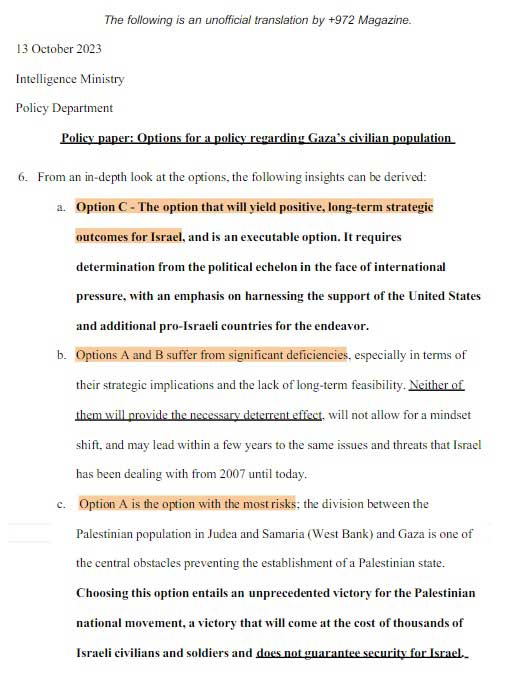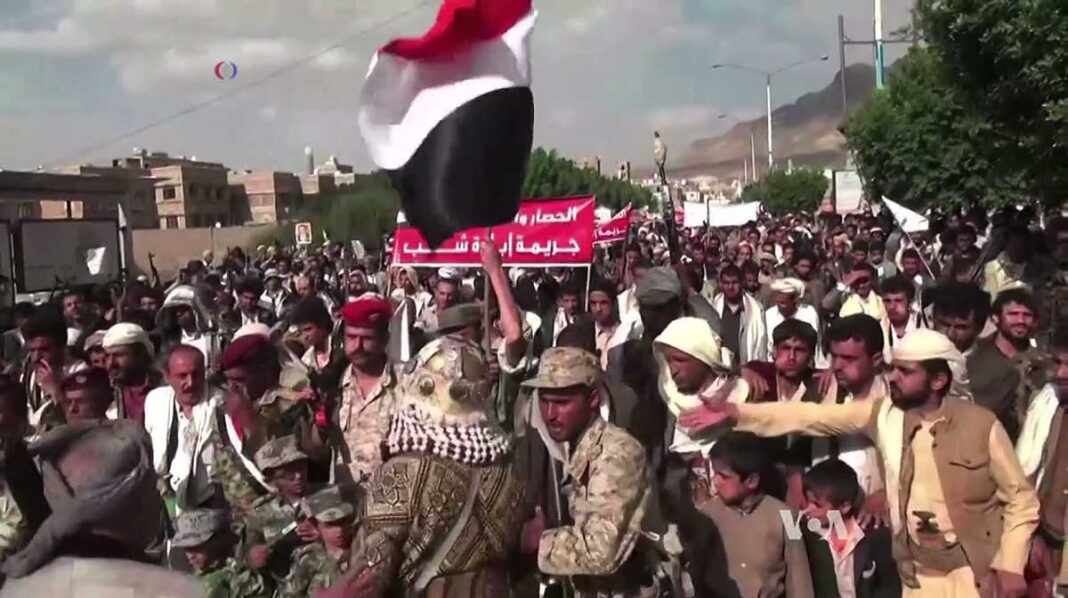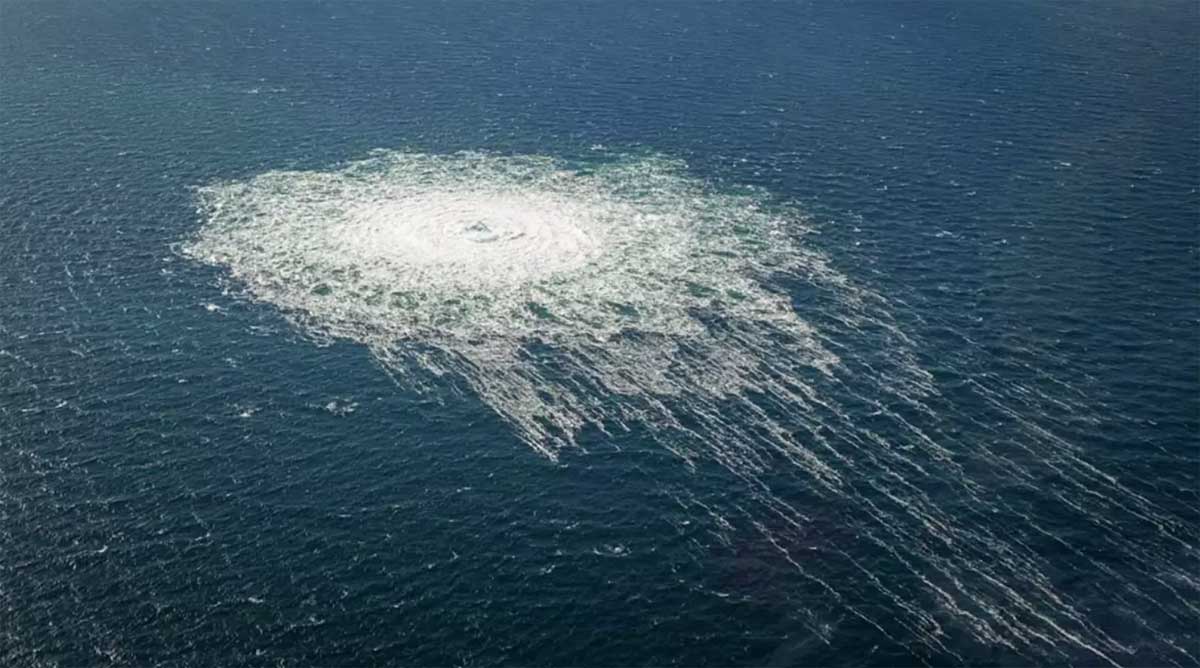Tuesday’s announcement came as residents reported shelling and airstrikes shaking the Nuseirat, Maghazi and Bureij camps.

Palestinians inspect the rubble of a building of the Al Nawasrah family destroyed in an Israeli strike in Maghazi refugee camp.
Adel Hana / AP
By AP via Scripps News
Dec 26, 2023
Israeli forces on Tuesday expanded their ground offensive into urban refugee camps in central Gaza after bombarding the crowded Palestinian communities and ordering residents to evacuate. Gaza's main telecom provider announced another "complete interruption" of services in the besieged territory.
The military's announcement of the new battle zone threatens further destruction in a war that Israel says will last for "many months" as it vows to crush the ruling Hamas militant group after its Oct. 7 attack. Israeli forces have been engaged in heavy urban fighting in northern Gaza and the southern city of Khan Younis, driving Palestinians into ever-smaller areas in search of refuge.
The U.S. said Israel's minister for strategic affairs, Ron Dermer, was meeting with Secretary of State Antony Blinken and national security adviser Jake Sullivan. Despite U.S. calls for Israel to curb civilian casualties and international pressure for a cease-fire, Israeli Prime Minister Benjamin Netanyahu said the military was deepening the fighting.
"We say to the Hamas terrorists: We see you and we will get to you," Netanyahu said.
Israel's offensive is one of the most devastating military campaigns in recent history. More than 20,900 Palestinians, two-thirds women and children, have been killed, according to the Health Ministry in Gaza, whose count doesn't differentiate between civilians and combatants. The agency said 240 people were killed over the past 24 hours.
As the U.S. remains one of the few countries opposed to a ceasefire in Gaza, protesters have urged the Biden administration to change its position.
The U.N. human rights office said the continued bombardment of middle Gaza had claimed more than 100 Palestinian lives since Christmas Eve. The office noted that Israel had ordered some residents to move there.
Israel said it would no longer grant automatic visas to U.N. employees and accused the world body of being "complicit partners" in Hamas' tactics. Government spokesman Eylon Levy said Israel would consider visa requests case by case. That could further limit aid efforts in Gaza.
Residents of central Gaza described shelling and airstrikes shaking the Nuseirat, Maghazi and Bureij camps. The built-up towns hold Palestinians driven from their homes in what is now Israel during the 1948 war, along with their descendants. The camps are now crowded with people who fled the north.
"The bombing was very intense," Radwan Abu Sheitta said by phone from Bureij.
The Israeli military ordered residents to evacuate a belt of territory the width of central Gaza, urging them to move to nearby Deir al-Balah. The military later said it was operating in Bureij and asserted that it had located a Hamas training camp.
The telecom outage announced by Paltel follows similar outages through much of the war. NetBlocks, a group that tracks internet outages, confirmed that network connectivity in Gaza was disrupted again and "likely to leave most residents offline."
Senior Hamas official Osama Hamdan said several countries had sent proposals to resolve the conflict following news of an Egyptian proposal that would include a transitional Palestinian government in Gaza and the occupied West Bank. He said Hamas "has been open to all initiatives that achieve a full cease-fire on the aggression on our people."
Regional spillover
Defense Minister Yoav Gallant said Israel faces a "multi-arena war" on seven fronts — Gaza and the West Bank, Lebanon, Syria, Iraq, Yemen and Iran. "We have responded and acted already on six of these," he told the Knesset's Foreign Affairs and Defense Committee.
Iranian-backed militia groups around the region have stepped up attacks in support of Hamas.
Iranian-backed militias in Iraq carried out a drone strike on a U.S. base in Irbil in northern Iraq on Monday, wounding three American service members, according to U.S. officials. In response, U.S. warplanes hit three locations in Iraq connected to a main militia, Kataib Hezbollah.
Almost daily, Hezbollah and Israel exchange missiles, airstrikes and shelling across the Israeli-Lebanese border. Around 150 people have been killed on the Lebanese side, mostly fighters from Hezbollah and other groups, but also 17 civilians. At least nine soldiers and four civilians have been killed on the Israeli side.
In the Red Sea, attacks by Houthi rebels in Yemen against commercial ships have disrupted trade and prompted a U.S.-led multinational naval operation to protect shipping routes. The Israeli military said a fighter jet on Tuesday shot down a "hostile aerial target" above the Red Sea that the military asserted was on its way to Israeli territory.
A mass grave
More than 85% of Gaza's 2.3 million people have been driven from their homes. Deir al-Balah and Rafah, in the south on the Egyptian border, have been overwhelmed with displaced people, even as Israel bombards them.
U.N. officials say a quarter of Gaza's population is starving under Israel's siege, which allows in a trickle of food, water, fuel, medicine and other supplies. Last week, the U.N. Security Council called for immediately speeding up aid deliveries, but there has been little sign of change.
In an area Israel had declared a safe zone, a strike hit a home in Mawasi, a rural area in the province of Khan Younis. One woman was killed and at least eight were wounded, according to a cameraman working for The Associated Press at the nearby hospital.
In response, Israel's military said that it wouldn't refrain from operating in safe zones, "if it identifies terrorist organization activity threatening the security of Israel."
Hamas' Oct. 7 attack in southern Israel killed around 1,200 people, mostly civilians, and took about 240 others hostage. Israel aims to free the more than 100 hostages who remain in captivity.
Israel blames Hamas for the high civilian death toll in Gaza, citing militants' use of crowded residential areas and tunnels. Israel says it has killed thousands of militants, without presenting evidence.
At the Kerem Shalom border crossing, U.N. and Gazan medical workers unloaded a truck carrying about 80 unidentified bodies that had been held by Israeli forces in northern Gaza. They were buried in a mass grave.
Medical workers called the odors unbearable. "We cannot open this container in a neighborhood where people live," Dr. Marwan al-Hams, health emergency committee director in Rafah, told the AP. He said the health and justice ministries would investigate the bodies for possible "war crimes."
In the north, Israeli troops are focusing on the Gaza City neighborhood of Daraj Tufah, believed to be one of Hamas' last strongholds in the area, according to reports from Israeli military correspondents, who receive briefings from army commanders.
Hamas has shown resilience. The Israeli military announced the deaths of two more soldiers, bringing the total killed since the ground offensive began to 161.
2023/12/26

An employee of the UN's Office for the Coordination of Humanitarian Affairs (OCHA) has described what she saw at the Al-Aqsa hospital in Gaza as "absolute carnage."
Gemma Connell told the BBC that there were many injured with "extremely severe wounds but [who] cannot be treated because there are so many people in front of them in the line for surgery, and the hospital is absolutely overloaded."
"Tragically I saw a nine-year-old boy with a devastating head injury who passed away," Connell was quoted as saying on Tuesday.
Israel's army has stepped up its operations against the Islamist group Hamas in the Gaza Strip, after Israeli Prime Minister Benjamin Netanyahu said during a troop visit to the sealed-off coastal strip that Israel would "intensify the fight in the coming days."
According to the Hamas-controlled Health Ministry in Gaza, more than 20,600 people have been killed so far in the latest war.
The Israeli army's offensive to eliminate Hamas from Gaza was triggered by the worst massacre in Israel's history, carried out by terrorists from Hamas and other groups on October 7. Around 1,200 people were killed and about 240 were taken hostage, some of whom were later released during a brief truce.
Large parts of Gaza have been destroyed during the Israeli offensive.


By AFP
December 25, 2023

Men recover the body of a victim killed after an Israeli strike at Al-Maghazi refugee camp in central Gaza - Copyright AFP Mahmud HAMS
Residents of Gaza’s Al-Maghazi refugee camp returned to their neighbourhood on Monday only to find blocks of concrete strewn where their homes had stood just a day ago.
“These houses are destroyed. Our house was bombed,” said camp resident Abu Rami Abu al-Ais amid the debris.
“There’s no safe place in the Gaza Strip.”
Late on Sunday three houses in the camp were hit by Israeli air strikes that killed at least 70 people, according to the health ministry in Hamas-run Gaza. AFP was unable to independently verify the information.
Israel says it issues evacuation orders and warnings so civilians can get to safety before military activity, but Zeyad Awad said there was no advisory before the strike.
“What should we do? We are civilians, living peacefully and wanting only safety and security,” he said.
“Yet we are suddenly struck by Israeli warplanes without any warning.”
The Israeli military said it was “reviewing the incident”.
“Despite the challenges posed by Hamas terrorists operating within civilian areas in Gaza, the IDF (military) is committed to international law including taking feasible steps to minimise harm to civilians,” it told AFP.
Swathes of the Gaza Strip have been razed in blistering Israeli bombardments during more than two months of war.
The conflict was triggered by an unprecedented attack by Hamas gunmen on southern Israel on October 7. They indiscriminately killed around 1,140 people, mostly civilians, according to an AFP tally based on the latest official Israeli figures.
The militants also took hostage about 250 people, Israel says.
In response, Israel launched a relentless retaliatory land, sea and air assault on the Gaza Strip, alongside a ground invasion aimed at destroying Hamas.
The offensive has killed at least 20,670 people, most of them women and children, according to Gaza’s health ministry.
– ‘They chased us’ –
On Monday returning camp residents were shocked to see the scale of destruction, some describing how their children had panicked when the blast occurred.
“The Israeli army does not spare civilians… They (are) causing extensive, enormous destruction and panic in the hearts of my children,” said Awad.
“My child said to me ‘Protect me. What’s happening? I can’t breathe.'”
AFP footage showed several residents walking through the debris, inspecting the damage caused by the night-time strike. Some hugged each other and burst into tears.
Several charred vehicles could be seen scattered on the roads, while children searched through the wreckage to find their books.
Al-Maghazi camp is one of several in Gaza and was established in 1949, according to the UN, to shelter refugees who fled hostilities at the time of Israel’s creation the year before.
Many who fled Al-Maghazi camp after the strikes on Sunday were doing so again, after already escaping attacks in northern Gaza.
One of them was Rawan Manasra, originally from Beit Hanun. The strike in the camp decimated her family, she said.
“They (Israeli army) killed my five brothers. I no longer have brothers. They killed them along with their children and wives,” Manasra told AFP.
“Every day there are strikes… They tell us to move from the north to the south, then they chase us and attack us.”
Dozens of wounded from Sunday’s strike were taken to Deir al-Balah hospital in central Gaza, one of the few hospitals still partly functioning. Some were on stretchers while volunteers carried others in their arms.
“It’s a massacre,” health ministry spokesman Ashraf al-Qudra said.
“Dozens of injured people are becoming martyrs due to the inability to treat them immediately,” he added.
Israeli strikes in Gaza have repeatedly struck hospitals, which are protected under international humanitarian law, and desperation is growing among medical staff over their inability to treat people.
The Israeli military accuses Hamas of having tunnels under hospitals and using the medical facilities as command centres, a charge the Islamist group denies.
Displacing a Nation: What Led to (and Caused) the Gaza-Israel Catastrophe
The Hamas-Israel War has devastated Gaza and displaced its people. It could result in expulsions in the West Bank over time.
BYDR. DAN STEINBOCK
DECEMBER 22, 2023

The Hamas-Israel War has devastated Gaza and displaced its people. It could result in expulsions in the West Bank over time. It is about the dispossession, displacement and devastation of a nation.
By mid-December, over 20,000 Palestinians, some 70 percent of whom are women and children, have been killed in the Hamas-Israel War (although these figures are likely to be gross underestimations) and 1.9 of the 2.3 million Palestinians displaced. If the Israeli offensive would last a year, which is the tacit goal of Israel’s far-right government, over 100,000 Palestinians would be dead by October 7, 2024. As talks continued on hostage deals and hundreds of thousands marched for peace in world capitals, the war has continued, despite a truce and loud calls for lasting ceasefire.
It is a dramatic narrative. But it is about the proximate causes of October 7, which has been in the cards for years.[i] Yet, ultimately, it is about longstanding ethnic cleansing and the effort to control huge offshore oil and gas reserves.
Secret memorandum on the Gazan population transfer
Barely a week after the Hamas attack on October 7, Israel’s Intelligence Ministry prepared a secret memorandum. It is this Ministry that oversees the Mossad and the Shin Bet, under the prime minister. In the 10-page memo, three options regarding the Palestinian civilians were predicated on “the overthrow of Hamas” and the “evacuation of the population outside of the combat zone”:Option A: Population remains in Gaza under Palestinian Authority
Option C: Population is evacuated from Gaza to Sinai.[ii]
Of these three options, the memo recommended C: the forcible transfer of Gaza’s 2.3 million residents to Egypt’s Sinai, as the preferred course of action. In the Ministry’s view, Egypt, Turkey, Qatar, Saudi Arabia, the UAE, and Canada would support the plan financially, or by taking in Palestinian refugees as citizens.
FIG 1 Secret Memorandum by the Israeli Intelligence Ministry

Two weeks later, the memo was leaked to the media.[iii] It sparked an international firestorm over the “advocacy for ethnic cleansing.” Yet, the option was promoted by the Intelligence Minister Gila Gamliel who claimed that members of the Knesset across the political spectrum were backing it.[iv] In regional view, it was a pipe dream nobody bought.
Certainly, the early stages of the Israel’s counter-offensive, “Operation Iron Swords,” reinforced the view that a population displacement is now at the forefront.
From “targeted killings” to mass exterminations
Two days after the Hamas offensive, IDF Spokesperson Daniel Hagari stated that “the emphasis is on damage and not on accuracy.”[v] What followed was the Israeli army’s expanded authorization for bombing non-military targets, the loosening of constraints regarding expected civilian casualties, and the use of an artificial intelligence system to generate more potential targets than ever before.”
The presumably “targeted killings” have absolutely nothing to do with ground realities as Gaza has morphed into a “mass assassination factory.” As even US intelligence has acknowledged, almost half of the Israeli munitions dropped on Gaza have been imprecise “dumb bombs.”[vi]
Since October 7, the strategic objective, which the Biden administration has tacitly accepted, has been to destroy Gaza’s infrastructure, exterminate its people and undermine its future.
As Prime Minister Netanyahu struggled to downplay the memo, the leak worsened Israeli-Egyptian tensions. Meanwhile, a pro-Likud think-tank outlined “a plan for resettlement and final rehabilitation in Egypt of the entire population of Gaza.”[vii]
But truth to be told, the transfer option isn’t exactly news. In Israel, such agendas had been disclosed already over three decades ago – and they were first implemented decades before.
Ethnic cleansing since 1947
Since the late 1980s, Israeli “new historians” – including Benny Morris, Ilan Pappé, Avi Shlaim and Simha Flapan – have revised Israel’s role in the 1948 Palestinian expulsion and flight. In contrast to their precursors, they argued that ethnic cleansing triggered what the Palestinians call the Nakba (“Catastrophe”); that is, the displacement and dispossession of Palestinians, and the devastation of their society. Even prior to these historians, the Nakba had been described as ethnic cleansing by many Palestinian scholars such as Rashid Khalidi, Adel Manna, and Nur Masalha.
What divided the Israeli new historians was the question whether the catastrophe was intentionally planned or collateral damage of the 1947 UN Partition Plan and the 1948 Israeli Independence. The damage idea was promoted by Benny Morris; the intentional interpretation by Ilan Pappé.[viii] Morris relied primarily on Hebrew sources; Pappé used both Hebrew and Arabic sources.
In light of historical evidence, ethnic expulsion has accompanied Jewish colonization in the Palestine ever since the 1880s and the beginning of the modern Zionist movement, as Pappé has argued with documentation. These expulsions were not decided on an ad hoc basis, as mainstream historians claimed. Instead, the Palestinian displacement and dispossession constituted ethnic cleansing, in accordance with the Plan Dalet (Plan “D”), drawn up in 1947 by Israel’s future leaders, such as David Ben-Gurion, the first prime minister of the nation. In this view, the aim has always been, and still remains, “to take over as much of Palestine as possible with as few Palestinians as possible.”[ix]
Today, the Palestinians in Israel, Occupied Territories, neighboring Arab countries and worldwide are the descendants of the 720,000 out of 900,000 Palestinians who once lived in areas that became Israel (Figure 5).
Figure 2 Ethnic cleansing in stages – before the 2023 Gaza War

In the pre-British Mandate map, the Palestinians comprised some 90% of the total population and the Jews the rest. In the 1947 Partition Plan, the UN granted 55% of Palestine to the new Jewish state and 45% to the non-contiguous Arab one, whereas Jerusalem was to be under international control. By the 1948 Israeli independence, the Jewish forces had already expelled some 750,000 Palestinians while capturing 78% of the historic Palestine. The remaining 22% was split into the West Bank and Gaza Strip. During the 1967 War, Israel occupied all historic Palestine and expelled another 300,000 Palestinians.
* Map mix from Al Jazeera
From demographic displacement to economic objectives
After a month of systematic devastation in Gaza, Netanyahu’s far-right defense minister Smotrich stated that the “voluntary migration” of Palestinians in Gaza is the “right humanitarian solution.” Israel would no longer put up with “an independent entity in Gaza.”
Meanwhile, Netanyahu lobbied European leaders to help him persuade Egypt to take in refugees from Gaza, without any success, even while he was downplaying his own Intelligence Ministry’s preferred proposal to “evacuate” all Palestinians. By contrast, Egyptian Foreign Minister Sameh Shoukry said his country rejected any attempt to justify or encourage the displacement of Palestinians outside Gaza.[x]
In the UN Security Council, ethnic cleansing was defined in 1992 as “a purposeful policy designed by one ethnic or religious group to remove by violent and terror-inspiring means the civilian population of another ethnic or religious group from certain geographic areas.”[xi]
It is this kind of demographic displacement that has motivated the ethnic cleansing of the Palestinians particularly since 1947. But the current efforts at population transfers, whether from Gaza or the West Bank, are no longer dictated by only demographic goals. Since the 1990s, ethnic cleansing seems to have also been motivated by economic objectives.
The original 7,400-word analysis was published by The World Financial Review (December-January issue), see https://worldfinancialreview.com/displacing-a-nation-what-led-to-and-caused-the-gaza-israel-catastrophe/
[i] Steinbock, D. 2018. “Israel’s 50-Year Time Bomb.” Consortium News, Oct 18.
[ii] Options for a policy regarding Gaza’s civilian population. Policy Dept. Israel’s Ministry of Intelligence. Oct 13, 2023.
[iii] “An Israeli ministry, in a ‘concept paper,’ proposes transferring Gaza civilians to Egypt’s Sinai”. AP News, Oct 30, 2023
[iv] Gamliel, G. 2023. “Victory is an opportunity for Israel in the midst of crisis.” Jerusalem Post, Nov 19.
[v] ““Emphasis is on damage, not accuracy’: ground offensive into Gaza seems imminent.” The Guardian, Oct 10, 2023.
[vi] Abraham, Y. 2023. “’A mass assassination factory’: Inside Israel’s calculated bombing of Gaza.” +972 Magazine, Nov 30; “Exclusive: Nearly half of the Israeli munitions dropped on Gaza are imprecise ‘dumb bombs,’ US intelligence assessment finds.” CNN, Dec 14, 2023.
[vii] “Zionist think tank publishes blueprint for Palestinian genocide.” The Grayzone, Oct 24, 2023. See also the think-tank’s website https://www.izs.org.il/ Soon afterwards the website went offline and Weitman’s paper was no longer downloadable.
[viii] Morris, B. 1988. The Birth of the Palestinian Refugee Problem, 1947-1949, Cambridge UP.
[ix] Pappe, Ilan. 2006. The Ethnic Cleansing of Palestine. Oneworld, p. 362.
[x] “Israeli minister supports “voluntary migration’ of Palestinians in Gaza.” Al Jazeera, Nov. 14, 2023.
[xi] “Final Report of the Commission of Experts Established Pursuant to United Nations Security Council Resolution 780 (1992).” UN Security Council. May 27, 1994. p. 33
Dr. Dan Steinbockis an internationally recognized strategist of the multipolar world and the founder of Difference Group. He has served at India, China and America Institute (US), Shanghai Institutes for International Studies (China) and the EU Center (Singapore). For more, see https://www.differencegroup.net/











